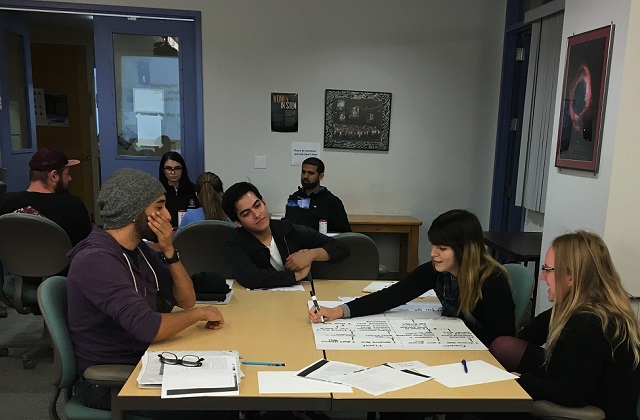
UC San Diego Hosts First Cal-Bridge Professional Development Workshop
Workshop launched at the university is part of program's aim to diversify state's ranks of physicists, astronomers
Published Date
By:
- Cynthia Dillon
Share This:
Article Content
A consortium of nine University of California (UC), including UC San Diego, and 15 California State University (CSU) campuses recently received a five-year, $5 million grant from the National Science Foundation to dramatically increase diversity in physics and astronomy through the Cal-Bridge program. Launched four years ago, Cal-Bridge creates a pathway for underrepresented minority (URM) students from multiple CSU campuses to attend PhD programs in physics and astronomy at UCs across the state. The new NSF grant allows Cal-Bridge to expand from about a dozen URM scholars per year, to as many as 50 statewide, who will benefit from substantial financial support, research opportunities and various workshops.
During Cal-Bridge's first professional development workshop, recently hosted by UC San Diego, Division of Physical Sciences’ astrophysicist Adam Burgasser introduced program scholars to the concept of growth mindset. This is the idea that intelligence, talent and even personality can be changed and developed as a strategy for persistence in students' physics and astronomy majors. The workshop also included a panel discussion with physics graduate students and a tour of the UC San Diego Cosmology Lab.
“It is well-documented that underrepresented students in physical science degree programs experience barriers to persistence, including stereotype threat and imposter syndrome,” said Burgasser. “We use growth mindset to teach our scholars how to recognize and overcome these barriers, and to focus on their growth as students and scientists.”
Burgasser is one of three UC San Diego faculty mentors in the Cal-Bridge program. Quinn Konopacky and Karin Sandstrom, also astrophysicists at the university, participate in the program by co-advising scholars with CSU mentors.
Cal-Bridge uses research-validated selection methods to identify students from URM groups who display strong non-cognitive abilities—skills like perseverance and teamwork—along with academic potential. Once selected, Cal-Bridge scholars receive up to $10,000 per year, based on demonstrated need, for up to three years. The scholars also benefit from intensive joint mentoring by UC and CSU faculty.
“Being a mentor for Cal-Bridge scholars is incredibly rewarding,” said Konopacky. “These students are exactly the types of scholars we are interested in attracting to our graduate program.”
The program leverages the cooperation of more than 150 physics and astronomy faculty at participating UC and CSU campuses to help qualified undergraduates from diverse backgrounds successfully complete their bachelor’s degrees in physics and matriculate to PhD programs. The long-term goal is for some of these scholars to return to California after earning their PhDs and become faculty at UC and CSU campuses, thus diversifying the state’s faculty ranks.
“This grant will increase representation nationwide by 50 percent, all from one program in California,” said Alexander Rudolph, a Cal Poly Pomona professor of physics and astronomy, and director of the Cal-Bridge program.
So far, the Cal-Bridge program has successfully developed a pipeline of highly diverse, qualified scholars, many of whom have already matriculated to PhD programs. In the last three years, 19 of 21 Cal-Bridge scholars who earned their bachelor’s degrees in physics have begun or will attend top PhD programs in physics or astronomy. Presently, the national average of URM minorities earning a PhD in these fields is about 80 per year.
“Cal-Bridge has already enhanced the pool of highly qualified applicants from underrepresented groups that apply to UC San Diego for graduate school,” noted Sandstrom.
UC San Diego is transforming California and a diverse global society by educating, by generating and disseminating knowledge and creative works, and by engaging in public service. At UC San Diego, the Division of Physical Sciences is where research and teaching excellence begins. The first students to enroll at UC San Diego when it was established in 1960 were graduate students in physics.
Share This:
You May Also Like
Stay in the Know
Keep up with all the latest from UC San Diego. Subscribe to the newsletter today.



